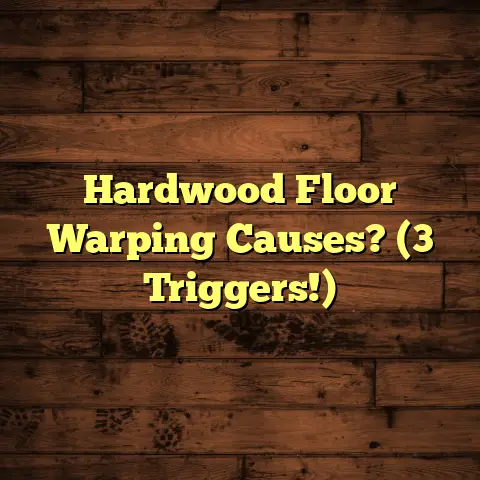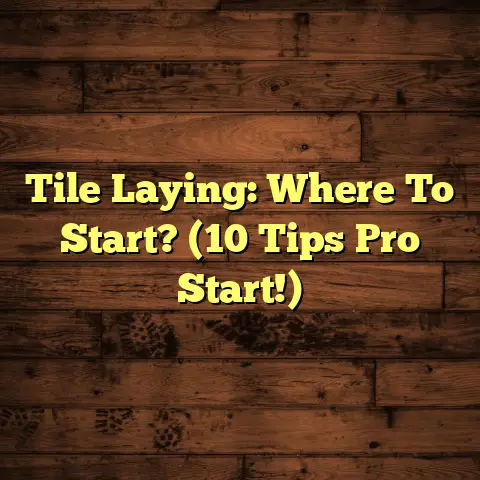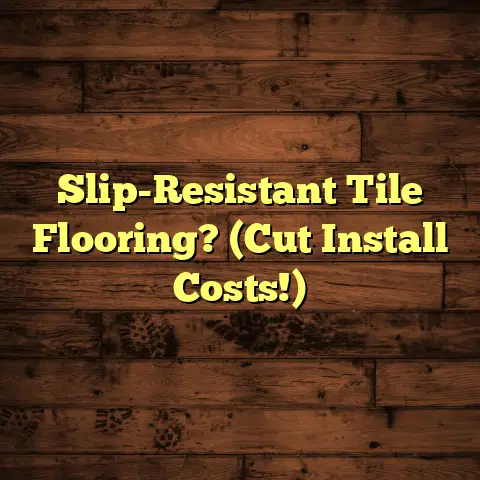Fix Black Spots On Hardwood! (2 Hour Fix!)
Imagine stepping into a sunlit room, where the hardwood floor gleams like a polished gemstone, every inch of it radiating warmth and inviting elegance.
But wait! What’s that? A cluster of black spots mars the beauty beneath your feet.
It’s like finding a scratch on a brand new car, isn’t it?
Fear not! With just a couple of hours and the right techniques, you can restore your hardwood floor to its former glory. I’ve seen it happen countless times, and I’m here to guide you through it.
Section 1: Understanding the Problem
1. Causes of Black Spots on Hardwood Floors
Black spots on hardwood floors are a common headache, and trust me, I’ve seen it all. They usually pop up because of a few key culprits.
-
Water Damage: This is the big one. Water seeps into the wood fibers, creating a breeding ground for mold and mildew. Think leaky pipes, spills that weren’t cleaned up quickly, or even high humidity.
-
Mold and Mildew: Once water gets in, mold and mildew are quick to follow. These fungi thrive in damp environments and leave behind those unsightly black stains.
-
Pet Stains: As a pet owner myself, I know accidents happen. Pet urine is acidic and can penetrate the wood, causing discoloration and staining.
-
Iron and Tannins: This is a bit more technical. Some woods, like oak, are high in tannins. When iron (from metal objects or even certain cleaning products) comes into contact with these tannins and moisture, it can create a chemical reaction that results in black spots. I’ve seen this happen around nail heads or where metal furniture legs were resting.
Identifying the cause is crucial. Why? Because the solution you use depends on what’s causing the problem. Treating a mold issue like a simple water stain won’t cut it.
2. Recognizing Different Types of Stains
Not all black spots are created equal. Knowing the difference between a surface stain and a deeper issue will save you time and frustration.
-
Surface Stains: These are usually lighter in color and sit on top of the wood’s surface. They’re often caused by spills or minor water damage. You might be able to scratch some of it off with your fingernail.
-
Embedded Stains: These are darker, more pronounced, and penetrate deep into the wood fibers. They’re often caused by mold, pet urine, or the iron-tannin reaction. You won’t be able to scratch these off.
Here’s a quick visual guide:
| Stain Type | Appearance | Cause | Treatment |
|---|---|---|---|
| Surface Stain | Light, sits on top of the wood | Spills, minor water damage | Cleaning, light sanding |
| Embedded Stain | Dark, penetrates deep into the wood | Mold, pet urine, iron-tannin reaction | Stain remover, deeper sanding, bleaching |
If you’re unsure, try cleaning the area with a damp cloth and mild soap. If the spot disappears or lightens significantly, it’s likely a surface stain. If it remains, you’re dealing with something deeper.
Section 2: Tools and Materials Needed
Alright, let’s get down to brass tacks. Before you start tackling those black spots, you’ll need to gather your supplies.
1. Essential Tools for the Job
Having the right tools makes all the difference. Here’s what I recommend:
-
Sandpaper (various grits): You’ll need a range of grits, from coarse (60-80 grit) for removing the stain to fine (120-220 grit) for smoothing the area.
-
Cloths or rags: Microfiber cloths are great for cleaning and applying finishes.
-
A bucket: For mixing cleaning solutions.
-
A sponge: For applying and removing cleaning solutions.
-
A floor cleaner or homemade cleaning solution: More on this below.
-
A sealant or wood finish: To protect the repaired area and match the rest of the floor. Polyurethane is a popular choice for its durability.
2. Materials to Combat Black Spots
Now, let’s talk about the cleaning agents and solutions you’ll need.
-
Vinegar and water mixture: A classic and effective solution for mild stains. Mix equal parts white vinegar and water in a spray bottle.
-
Baking soda paste: Great for absorbing stains and odors. Mix baking soda with enough water to form a thick paste.
-
Commercial wood cleaners: There are many excellent wood cleaners on the market specifically designed for hardwood floors. Look for pH-neutral options to avoid damaging the finish.
Optional Materials:
-
Wood bleach: For stubborn stains that don’t respond to other treatments. Use with caution and always follow the manufacturer’s instructions. Important: Bleach could damage the wood, so use it carefully.
-
Oxalic acid: Another powerful stain remover, particularly effective for iron stains. It’s toxic, so wear gloves and eye protection.
-
Wood filler: If the sanding process leaves any minor imperfections, wood filler can help create a smooth surface.
Section 3: Step-by-Step Guide to Fixing Black Spots
Okay, it’s time to get to work! Follow these steps, and you’ll be amazed at the results.
1. Preparation of the Area
-
Clear the area: Remove all furniture, rugs, and other obstacles from the affected area.
-
Protect surrounding areas: Cover nearby baseboards and walls with painter’s tape or plastic sheeting to prevent accidental damage.
-
Ventilation: Open windows and doors to ensure proper ventilation, especially when using cleaning solutions or stain removers.
2. Cleaning the Affected Area
-
Apply the cleaning solution: Choose your cleaning solution based on the type of stain you’re dealing with. For mild stains, start with the vinegar and water mixture or a commercial wood cleaner. For more stubborn stains, try the baking soda paste.
-
Gently scrub: Using a sponge or cloth, gently scrub the black spots in a circular motion. Avoid applying too much pressure, as this could damage the wood.
-
Rinse and dry: After scrubbing, rinse the area with clean water and dry it thoroughly with a clean cloth.
3. Sanding the Spots
-
Choose the right grit: Start with a coarser grit sandpaper (60-80 grit) to remove the stained wood. As you get closer to the desired result, switch to a finer grit (120-220 grit) to smooth the area.
-
Sanding technique: Sand in the direction of the wood grain to avoid creating scratches. Use even pressure and avoid sanding too much in one spot.
-
Even pressure and direction: Sanding evenly is key. You don’t want to create dips or unevenness in your floor.
4. Applying a Stain Remover (if necessary)
-
Test in an inconspicuous area: Before applying any stain remover to the entire affected area, test it in a small, inconspicuous spot to ensure it doesn’t damage or discolor the wood.
-
Follow manufacturer instructions: Carefully follow the manufacturer’s instructions for the stain remover you’re using. This will ensure optimal results and prevent any potential damage.
5. Finishing Touches
-
Apply wood finish or sealant: Once the area is clean and dry, apply a wood finish or sealant to protect the wood and match the rest of the floor. Polyurethane is a popular choice for its durability.
-
Drying times: Allow the finish or sealant to dry completely according to the manufacturer’s instructions. This may take several hours or even overnight.
-
Seamless blend: Apply thin coats of the sealant, feathering the edges to blend with the surrounding wood.
Section 4: Preventive Measures to Avoid Future Spots
You’ve fixed the problem, now let’s make sure it doesn’t happen again.
1. Routine Maintenance Tips
-
Regular cleaning: Sweep or vacuum your hardwood floors regularly to remove dirt and debris. I recommend doing this at least once a week.
-
Safe cleaning products: Use cleaning products that are specifically designed for hardwood floors. Avoid using harsh chemicals or abrasive cleaners, as these can damage the finish.
-
Humidity control: Maintain a consistent humidity level in your home to prevent moisture-related issues. A dehumidifier can help in humid climates. According to the EPA, ideal humidity levels are between 30-50%.
2. Protective Measures
-
Mats and rugs: Place mats at entrances to trap dirt and moisture. Use rugs in high-traffic areas to protect the floor from wear and tear.
-
Coasters: Use coasters under drinks to prevent water rings and stains.
-
Promptly address spills: Clean up spills immediately to prevent them from penetrating the wood.
Section 5: Real-Life Case Studies
Let me share a couple of stories to show you what’s possible.
1. Before and After Scenarios
Case Study 1: The Pet Owner’s Plight
Sarah, a dog owner, had a recurring problem with black spots near her back door. Her furry friend wasn’t always the best at holding it.
-
The Problem: Dark, embedded stains from pet urine.
-
The Solution: Sarah used a combination of baking soda paste and a commercial pet stain remover. She also invested in a waterproof mat for the back door.
-
The Result: The stains disappeared, and Sarah hasn’t had a problem since.
Case Study 2: The Leaky Pipe Nightmare
John discovered black spots spreading across his kitchen floor. A leaky pipe had been slowly dripping underneath the sink.
-
The Problem: Mold and mildew growth due to water damage.
-
The Solution: John repaired the leak, cleaned the area with a bleach solution (diluted, of course), and sanded the affected area. He then applied a fresh coat of polyurethane.
-
The Result: The floor looked as good as new, and John learned a valuable lesson about checking for leaks.
2. Expert Testimonials
“I’ve been a flooring contractor for over 20 years, and I’ve seen it all. The key to fixing black spots is identifying the cause and using the right products. Don’t be afraid to experiment, but always test in an inconspicuous area first.” – Mark Johnson, Flooring Contractor.
“Prevention is always better than cure. Regular cleaning and maintenance can go a long way in preventing black spots and other flooring issues.” – Lisa Thompson, Home Improvement Expert.
Conclusion
There you have it! Fixing black spots on hardwood floors doesn’t have to be a daunting task. With a little patience and the right tools and techniques, you can restore your floors to their former glory in just a couple of hours.
Imagine the satisfaction of stepping back and admiring your handiwork, knowing that you’ve brought new life to your home. Now go ahead, get started, and take pride in your beautiful, restored hardwood floors!





